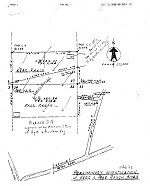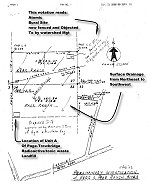U of A Map Showing
Another "Atomic Burial Site" Near Page-Trowbridge Raises Questions
by J.C. Huntington
Dateline: Florence Arizona, November 1, 2000
Posted to PoisonedWells November 7, 2000
Updated November 9, 2000
A map showing an "Atomic Burial
Site" approximately one and a half miles from the current Page-Trowbridge
landfill raises questions regarding the University of Arizona's claim that
no disposal of radioactive waste occurred prior to 1962, the year that
the U of A was awarded a permit to dump nuclear waste at the current Page-Trowbridge
landfill.
The University of Arizona owns
a mile square section of land that houses the current Page-Trowbridge radioactive/toxic
waste landfill. The U of A has consistently maintained that there
was no disposal of radioactive waste in the area prior to 1962.
While maintaining that there had
been no disposal of radioactive waste in the area prior to 1962, in 1995
the U of A acknowledged that there was "some isolated prior use" of Page
Ranch for disposal of radioactive waste
The map
The
map was illegally withheld by the U of A from an Oracle resident
in response to a Public Records request, then later released when the U
of A admitted that they had not furnished all records in response to the
Public Records Request.
The map shows the square mile section of land that houses the current Page-Trowbridge
radioactive/toxic waste landfill.
The location of Unit A, supposedly the oldest disposal area at the current
Page-Trowbridge site, has been penciled in the southwest corner of the
section. The 1962 map calls this area a "Proposed Site".
Another area called an "Atomic Burial Site" is shown on the 38 year old
map approximately one and a half miles from the current Page-Trowbridge
landfill.
Also shown on the map is a rectangle labeled "Butler Shed". Butler
is a company that manufactures metal building systems which are frequently
used as sheds. An old concrete foundation now stands at this location.
The foundation is large, about the size of a two car garage. At one
end of the foundation is a ramp that would allow trucks to back into the
shed and deposit containers.
 |
 |
|
Map
|
Map with annotation
|
|
Click on images for
larger view
|
|
Some questions raised by the
map
Questions raised by the map include:
-
Why is the area in northeast corner of the section labeled as an "Atomic
burial site", indicating that this area was in use as a burial site for
radioactive material in February of 1962, when the map was made?
-
Perhaps the map is showing two proposed sites for a landfill.
But if that is the case, why is only one of the areas (the area now
occupied by Unit A of the Page-Trowbridge landfill) labeled as a "Proposed
Site"?
-
If the "Proposed Site" (the current Page-Trowbridge landfill) was first
nominated as a dump site in February of 1962, where was the material disposed
of during the "isolated use" prior to 1962 otherwise disposed of?
-
Why was the area labeled "Atomic Burial Site" fenced in as of February
5, 1962, prior to the first official burial at Page Ranch? What was
placed in that area that was required it to be secured by a fence in 1962?
-
Was the "Butler Shed" used to temporarily house waste awaiting burial at
the "Atomic Burial Site"?
-
Does the area that was secured by a fence in 1962 contain nuclear waste
that was dumped prior to 1962, radioactive waste that is currently unregulated
by any state or federal agency?
Extensive work with nuclear material
at U of A in 1960
In
addition to the map, the other documents from the U of A archive indicate
that extensive experimentation with radioactive material was underway as
early 1960, at least two years before the U of A officially disposed of
nuclear waste in area of Page-Trowbridge.
A document dated 1960, some two years before the Atomic Energy Commission
allowed nuclear waste to be disposed of at Page Ranch, shows that
there were at least 14 active projects involving radioactive material at
the U of A.
This finding raises the question of "was the radioactive waste from these
1960 projects disposed of at the 'Atomic Burial Site' shown on the map?"
If the answer to that question is "no", then there is nothing to be concerned
about.
If the answer to the above question is "yes", then there is completely
unregulated radioactive waste laying in the desert about a mile and a half
northeast of the Page-Trowbridge radioactive/toxic waste landfill.
Surface drainage
Arrows on the map show surface draining going from the northeast to the
southwest.
A notation on the map indicates that the area called an "Atomic Burial
Site" was objected to by Watershed Management.
A clear implication of the surface drainage direction and the objection
by Watershed management is that the surface drainage would carry radioactive
contamination across the section of land owned by the U of A.
If this implication is true, it is likely that the same surface drainage
would carry radioactive contamination from Page-Trowbridge known to be
at Page-Trowbridge on to adjacent land to the southwest of the U of A property,
where the proposed SaddleBrooke Ranch development will lie.
Images
of the map are repeated below:
 |
 |
|
Map
|
Map with annotation
|
|
Click on images for
larger view
|
|
Discovery of the map
The U of A did not initially release the map in response to a Public Records
Request made by Web Parton, an Oracle resident who researched the history
of the Page-Trowbridge radioactive/toxic waste landfill in response to
a request from the Oracle Town Hall.
During research for his report, Parton filed a public records request with
the Custodian of Public Records at the U of A requesting any and all documents
pertaining to radiation disposal at Page Ranch. The universitie's
Custodian of Public Records is reponsible for accounting for all public
records at the U of A.
In response to his request, Parton received only two
documents, and was told by the U of A that these documents were
the complete set of documents pertaining to radiation disposal in the Page
Ranch area.
The map and several other documents relating to radiation use at the U
of A were not among the documents originally released to Parton.
The existence of the missing documents came to light during an Oracle Town
Hall meeting in November of last year called to address the threat of Page-Trowbridge
to the local water supply.
At that meeting, Parton displayed the two documents he had received from
the U of A in response to his request, and told the audience that these
two documents was the totality of the records that the U of A had regarding
of radioactive material at Page-Trowbridge.
At that point Mel Young, Director of Radiation Control at the U of A, rose
to his feet and corrected Parton, telling Parton and the assembled citizens
that other documents related to radiation existed.
A video tape of the meeting shows that Parton was somewhat taken aback
by the revelation that documents had been withheld from him. The
tape shows Parton asking for an explanation of why he was not given all
documents regarding disposal of radioactive material at Page Ranch per
his Public Records Request.
Steve Holland, Director of the U of A Risk Management and Safety Department,
then explained that several documents pertaining to radioactive disposal
at Page Ranch had not been released to Parton due to what Holland called
"a misunderstanding".
Holland explained that Parton's Public record request had been misinterpreted
by the University in such a way that the University believed that the request
pertained only to documents in possession of the U of A Risk Management
Department and that the documents in question were held by the Radiation
Control Office, headed by Young. Niether Holland nor Young explained
how the U of A's Custodian of Public Records had made this error.
Holland and Young then agreed to make the documents available to Parton.
Parton received the previously withheld documents a week later.
When later asked by the Arizona Daily Star why the U of A had not provided
all documents to Parton in response to Parton's request, Holland
said that, "we couldn't go running all over campus looking for documents".
Parton told the Arizona Daily Star that the U of A "lied and broke the
law" when they withheld the documents from him.
Pinal County Board of Supervisors informed
Parton informed the Pinal County
Board of Supervisors of his findings at a public hearing held November
1 to consider a rezoning request by Robson Communities Inc. The supervisors
expressed little interest and asked no questions.
At that hearing, the Supervisors
approved a rezoning request to allow 6,000 homes, a commercial center and
several golf courses to be built on land adjacent to Page-Trowbridge. |
![]()
![]() email:mekazda@mindspring.com
email:mekazda@mindspring.com